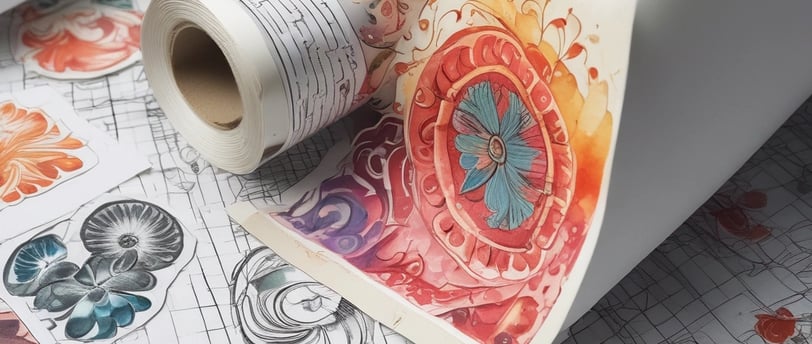Top 12 Sublimation Mistakes & How to Fix Them
Discover the top 12 sublimation mistakes and how to fix them. Get expert tips to troubleshoot issues like ghosting, faded colors, and print alignment.
SUBLIMATION
6/2/20254 min read


Sublimation can be a dream for crafters—when it goes right. But if you've ever pulled a project off your press only to see dull colors, ghosting, or just a mess, you know how frustrating it can be.
Don't worry—you’re not alone, and the good news is: most mistakes are totally fixable. In this post, we’ll walk you through the 12 most common sublimation mistakes and exactly how to fix (and prevent) them.
1. Dull or Faded Colors
What’s going wrong: Your colors aren’t popping like you expected.
The Fix:
Make sure you’re printing on true sublimation paper, not regular copy paper.
Confirm that you're using sublimation ink (not pigment or dye).
Set your print settings to high quality or photo and mirrored.
Check that your heat press is hot enough (usually 385–400°F) and pressed long enough (45–60 seconds depending on the material).
Sublimation colors always look dull on paper but brighten after pressing.
Consider using an ICC color profile specific to your printer and ink for accurate colors.
Also, use RGB color mode when designing for sublimation.
2. Using the Wrong Materials
What's going wrong: You press your beautifully designed image onto a t-shirt… and the result is dull, faded, or barely there. What happened?
The Fix:
Sublimation only works on polyester or polymer-coated materials. If you’re working with 100% cotton or untreated surfaces, the ink won’t bond properly.
Stick with:
Blanks that are at least 65% polyester (the higher, the better for vibrant results).
Items specifically labeled as sublimation-ready (like mugs, tumblers, and keychains with a poly-coating).
🛠️ Pro Tip: Want to sublimate on cotton? Try sublimation HTV (heat transfer vinyl) or sublimation sprays to prep the fabric first.
3. Pressing the Wrong Side of the Sublimation Paper
What’s going wrong: Nothing shows up on your blank.
Fix it:
Always double-check that you're printing and pressing on the coated side of the sublimation paper. It’s usually whiter or has a slight texture difference.
4. Too Much or Too Little Pressure
What’s going wrong: Uneven transfer, light spots, or blurry edges.
Fix it:
Adjust your heat press pressure to medium-firm. Not enough pressure = poor transfer. Too much pressure = distortion.
If using a mug press or tumbler press, be sure the size fits the press snugly.
5. Scorch Marks or Yellowing
What’s going wrong: Your blank has burn spots or looks yellowed after pressing.
Fix it:
This usually means too much heat or pressing for too long.
Lower the temperature slightly or reduce the press time. Most materials do well at 385–400°F for 45–60 seconds.
Use butcher paper, parchment paper or teflon sheet between the blank and the press to protect it.
6. Ink Bleed or Smudging
What’s going wrong: Ink runs or looks messy on your blank.
Fix it:
Let your prints fully dry before pressing—usually 5–10 minutes.
Avoid touching the printed design before pressing.
Store your sublimation paper and prints in a dry place to prevent moisture buildup.
7. Lines or Banding in the Design
What’s going wrong: Your print has visible horizontal lines.
Fix it:
Your printer nozzles might be clogged—run a nozzle check and cleaning cycle.
Make sure you’re using the correct paper settings for your printer.
Always keep your sublimation printer in regular use—unused nozzles dry out fast.
8. Not Using Blowout Paper
What’s going wrong: Ink transfers onto your heat press or through to the back of your blank.
Fix it:
Always use butcher paper (parchment or copy paper) on top and below your blank to catch excess ink.
It protects your press and prevents ink transfer to other projects.
9. Incorrect Temperature or Time Settings
What's going wrong: Your design looks burned, or maybe it’s not fully transferred—colors are faded, or areas are missing.
The Fix:
Sublimation is picky about heat! Too much time or temperature can cause ghosting or burns, while too little won’t allow the ink to fully transfer.
Always:
Follow the recommended settings for both the sublimation paper and the blank.
Use a reliable heat press with an accurate timer and thermometer.
🛠️ Pro Tip: Keep a heat setting logbook. Once you’ve found the perfect settings for mugs, shirts, and other blanks, write them down!
10. Not Securing the Design Properly
What's going wrong: Your image shifts during pressing, leading to a blurry, shadowed, or double image effect—aka ghosting.
The Fix:
Make sure your sublimation paper stays in place with heat-resistant tape. For tricky surfaces, temporary adhesive spray can help.
Tips:
Tape down edges securely, especially for curved or vertical surfaces like mugs or tumblers.
Avoid taping across the design area—just secure the edges.
🛠️ Pro Tip: Use a lint roller or heat glove to smooth the paper before taping, so everything stays flat and aligned.
11. Poor Image Quality
What's going wrong: Your final project looks pixelated, washed out, or not as sharp as you hoped.
The Fix:
Sublimation requires high-quality, high-resolution images. Make sure you're using files that are:
300 DPI or higher (for sharpness)
In PNG format with a transparent background (if needed)
Printed in mirror mode with correct color profiles
🛠️ Pro Tip: Always do a test print on regular paper first. That way, you catch any sizing or resolution issues before wasting expensive sublimation paper.
12. Moisture or Contamination
What's going wrong: Your design has strange spots, faded patches, or uneven color. Sometimes there’s even a “steamed” look.
The Fix:
Moisture is the enemy of sublimation. Even a small amount can distort your results.
Avoid this by:
Storing paper in a dry container (humidity ruins it!)
Pre-pressing fabric items for 5–10 seconds to remove moisture
Wiping down hard blanks with a lint-free cloth before pressing
Conclusion
Sublimation is a fun, rewarding craft—but like all creative processes, it comes with a learning curve. By watching out for these common mistakes, you can save time, avoid wasted blanks, and make each project a success.
Inspiration
Empowering crafters with tools and resources.
© 2025. All rights reserved.
Affiliate Disclosure
At TAG Designs Co, we believe in full transparency. Some of the links on this site are affiliate links, which means we may earn a small commission—at no extra cost to you—if you make a purchase through them. We only recommend products we genuinely use, love, and trust in our own crafting journey. These commissions help support the blog and allow us to keep sharing free tips, tutorials, and inspiration with our crafty community. 💛
Thanks for supporting what we do!
